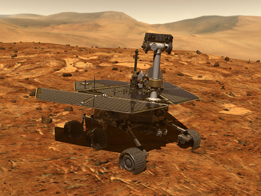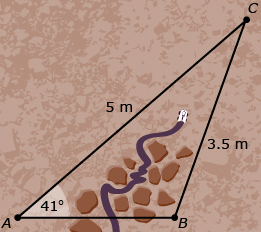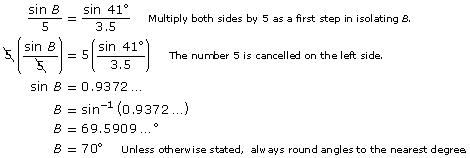Lesson 4
1. Lesson 4
1.4. Explore 3
Module 2: Trigonometry
Using the Sine Law to Solve for Angles
The sine law can also be used to solve for angles. When using the sine law, solving for an unknown is easier when the unknown is in the numerator. For this reason, the following equivalent form of the sine law is usually used when solving for angles:

Courtesy NASA/JPL-Caltech
You have looked at mapping land surface with examples from England, Alberta, and early First Nations peoples. The same mathematics is also useful in exploring outer space! In July 2003, NASA launched the Mars exploration rovers Spirit and Opportunity. The rovers’ 90-day missions were designed to investigate the history of water on Mars using a number of onboard science instruments.
At the beginning of each Mars day, each rover receives a set of instructions that tells the rover where to go and what scientific experiments to perform at each location. It is up to the rovers’ hazard avoidance software to determine how to get to each location. Look at Mars Terrain Images to see examples of the types of terrain the rovers must navigate around. The multimedia piece shows real images from Mars—none are artist’s conceptions. In each image, see if part of a Mars rover is visible.
Sending instructions from Earth on where the rovers should go and what experiments should be performed takes time. Round-trip communication time ranges from 6 min (when Mars is closest to Earth) to 44 min (when Mars is farthest from Earth). This time delay is much too long to allow real-time control of the rovers. For this reason, the rovers must determine their own paths for getting to targets.
Example 2: Mars Exploration Rover
The Mars exploration rover Opportunity has been given instructions to go from point A directly east to point B. Due to obstacles in its path, the Rover Hazard Avoidance software has picked a path that has the rover going at an angle of 41° for 5 m toward C and then going 3.5 m to get to B.

The rover software must determine ∠C so it can determine the correct angle to rotate once the rover reaches point C. The first step is to determine ∠B using the sine law. You will complete the last step, calculating ∠C, after Try This 2.
Step 1: Determine ∠B using the sine law. In other words, write the sine law using a side-angle pair that you know and the side-angle pair with the unknown angle.

Wait a minute! ∠B in the initial diagram is clearly greater than 90°, but a value of 70° was calculated. How can this be? It turns out that the math is correct, but there is something subtle going on. You might like to think back to finding solutions for sin θ = k, where −1 ≤ k ≤ 1.
Try This 2
The given information in Example 2: Mars Exploration Rover was as follows:
- ∠A = 41°
 = 5 m
= 5 m
 = 3.5 m
= 3.5 m
Use Mars Rover Example to see if another solution is possible—a solution that resembles the oblique triangle shown in the image at the beginning of Example 2: Mars Exploration Rover. The applet allows you to move point B while keeping the measurements provided as given information.
You should have been able to construct two triangles: one with ∠B = 70° and the other with ∠B = 110°. Mars Rover Triangle: Given Information will help you understand why there are two triangles with the measurements specified.
Knowing that the correct value for ∠B is 110° allows you to complete the final step of your calculation.
Step 2: Calculate ∠C using the fact that the sum of angles in any triangle always adds to 180°.



